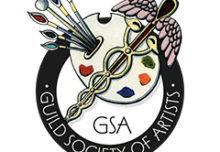….VERNISSAGE and RED DOTS…..
This blog follows on from the previous blog about ‘Product Launches’ for Artists, and the value of ‘Private Views’.
In the art-world a Private View is a very good example of a Product Launch that many non-art businesses must envy. PV’s are good for producers (artists), distributors (galleries) and buyers (collectors). Also ‘patrons’ can benefit. So that is why we organize Private Views.
And here are some more dimensions to this.
Extra benefits.
In Sweden, where I had an exhibition of my paintings a while ago, the host gallery showed me how much the galleries enjoy these occasions. When we had hung my exhibition the gallery owner told me that the ‘Vernissage’ or Private View was to be on the next Sunday.
And the surprising fact was that nearly all the art galleries in the centre of Gothenburg were holding their own Vernissage events at the same time. This was a regular system meaning that an art lover could come into town on a free-parking day and visit several art shows one after another.
Every gallery would invite their own mailing list of established collectors and fans. The visitors would come to one gallery by invite and often visit another one. Galleries could gain by meeting unknown but real buyers. The galleries shared their pool of art lovers.
This also encouraged these art lovers to develop their interest in art. By visiting more than one preview they could meet more than one art dealer, and artist. And maybe they would share experience with other collectors. It made the once a month Sunday afternoon Vernissage visit much more attractive and interesting.
So Vernissage is a ‘Private View’ invitation day with a bunch of extra benefits. So the AIDA mantra of Attention, Interest, Desire, Action is half done already.
History.
My Swedish hosts told me that ‘Vernissage’ actually translates from the French for ‘Varnishing’. And ‘Varnishing Day’ rang a bell in my memory.
In the earlier history of the highly prestigious Royal Academy Summer Exhibition held in London there are tales of interesting events. The exhibition organisers used to hang the exhibition, and on the day before it opened to the public, they allowed a varnishing day opportunity for artists to come in and add a final coat of varnish to their work.
It is said that Turner would attend the preview opportunity and see what his rival artists were showing. And some other artists were doing the same. But Turner would have left out something from the painting. He would then add a bit more than just varnish to his exhibit. A final object or flourish would be painted at the last minute. The wet paint would become a talking point for visitors the next day.
Varnishing Day developments.
However ‘varnishing day’ was exploited a little more.
On varnishing day artists would secretly bring in their best collectors to see the exhibition first before the general public. This meant that any established dedicated fan would get first chance to buy the best exhibits from their artist. Collectors competed for the privilege.
But this sneaky trick had a consequence. Eventually the exhibition organizers recognized what was going on and established a ‘Private View by Invitation’ just before the opening day.
The exhibition organizers stipulated that all exhibits must be for sale because the Summer Show was to show new work and the Academy wanted to get their commission on all sales.
So the public on the opening day might see an exhibition with some of the best artworks adorned with red dots meaning that these paintings were already sold. Artists could actually sell out the day before the show had started. That meant that that artist gained a very high reputation as an artist to watch. Their collector base would grow with disappointed fans wanting to be invited to the next PV occasion. And the Academy still got their commission.
Red Dots
Red dots are stuck onto exhibit labels that show title, artist, price, and other information. This is to let everyone know that this particular painting has already been sold and is not now for sale.
There are stories of art galleries that put red dots on some of the art in a new show to encourage potential buyers to make a decision while there is still something to buy. Just a small example would be sufficient. These red dots can be taken off as soon as actual sales take place on other pieces.
But this trick can go wrong as well. If the gallery over does it they don’t leave enough choice for prospective buyers.
If the artist or their friends come to see their show they might also think that these false red dots mean that real sales have been made. Stories of artists celebrating and over-spending are told. The artist comes to get paid at the end of the show only to find that actually the total sales are much less than displayed, or even that no sales at all were actually achieved.
I cannot say that this happened to me anywhere, so it might all be a story.





